
Ensuring safety in power plant operations is essential as any negligence could lead to accidents. These accidents could range in severity from minor incidents to major boiler blasts such as the one that occurred at the Unchahar thermal power plant (TPP) in November 2017, one of the worst industrial disasters in recent times. To ensure plant safety, developers are taking measures such as timely maintenance of equipment and training of ground-level employees handling the machinery. At the policy level, efforts are being made to create a framework to check the recurrence of accidents like the Unchahar incident.
Based on the recommendations of a committee looking into the Unchahar blast, the Central Electricity Authority (CEA) recently issued an advisory to all TPPs to ensure timely commissioning of equipment/systems such as control and instrumentation (C&I), control loops and wall soot blowers; maintain adequate ash handling capacity; and follow standard operating procedures, etc.
Regulatory and policy initiatives
Based on the provisions of Section 53 of the Electricity Act, 2003, the CEA framed the CEA (Measures Relating to Safety and Electric Supply) Regulations, 2010 and the subsequent amendment. The safety regulations are applicable to all installations in the country. Further, Section 162 of the Electricity Act, 2003 directs the central/state governments to have their own electrical inspectorates to enforce safety regulations at installations under their jurisdiction. In the event of an electrical accident, the chief electrical inspector/electrical inspector appointed by the appropriate government conducts an inquiry on a case-by-case basis.
CEA advisory
Following the blast in the boiler section at the 500 MW Unit 6 of NTPC Limited’s Feroze Gandhi Unchahar Thermal Power Station in Uttar Pradesh in November 2017, the Ministry of Power had set up a committee to investigate the cause of the blast and suggest remedial measures to avoid such incidents in future. For a similar purpose, another committee was constituted by the Department of Heavy Industries, Ministry of Heavy Industry and Public Enterprises. Based on the recommendations of the committees for the safe operation of TPPs, the CEA has issued an advisory to all TPPs in the country. Issued in January 2019, the key recommendations under the advisory to be followed by the power utilities are as under:
- All systems and facilities including C&I, control loops, wall soot blowers and long retraceable soot blowers should be completed before the commissioning of the unit/plant.
- The ash handling capacity of bottom ash handling system, economiser ash handling system, air preheater ash handling system and electrostatic precipitator for fly ash handling system should be designed keeping in view the likely maximum ash content of coal.
- Water injection for dislodging of ash build-up over the furnace bottom should be avoided. However, if water jetting is necessary, it should be undertaken without compromising stable combustion conditions inside the boiler.
- The standard operating procedures/ local management instructions of the plant should be periodically reviewed. Further, the plant operating instructions should be in line with the original equipment manufacturer’s recommendations. The permit system of undertaking operations and maintenance (O&M) activities should be endorsed by the safety department, in addition to the O&M department.
- No maintenance work should be undertaken when the boiler is in operation. Besides, proper communication regarding maintenance work should be made to avoid any risky operations.
- The persons working in the ash handling area should be provided with thermal wear, which can withstand high temperatures. Flame-proof clothing should be provided to people working near the furnace area.
- The plant engineers deployed at different levels should have adequate and relevant experience.
- The control room logbooks should be filled in a proper manner, indicating the prevailing status of key unit parameters, operating parameters of major equipment/systems and shift activities in chronological order.
Emerging solutions
An emerging trend in power plant safety is the use of digital solutions. Power plant developers are promoting the use of wearables and tablets at hazardous locations, so that any exigency can be communicated at the earliest. These devices also help in quick consultation with the senior management for deciding the course of action in case of an emergency. Apart from this, depending on the plant requirements, developers are using robots that can be remotely operated for monitoring operations in areas that have security concerns. With robots, the task can be completed in a more safe and efficient manner. Digitalisation of plant operations also helps in maintaining safety. With the use of internet of things and predictive maintenance tools, real-time plant performance data can be obtained and anomalies in performance parameters identified. Besides, with detailed analyses of plant performance, potential hazards can be averted.
To conclude, adhering to standard operating procedures at plants and maintaining equipment health will go a long way in ensuring safe operations and preventing harm to human life and property.
